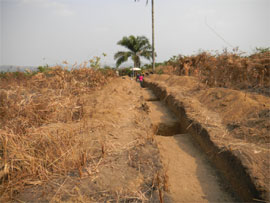
Kindoki 4, southern trench
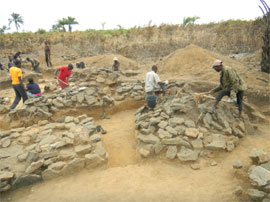
Excavation of the Iron Age burials on Kindoki 4.
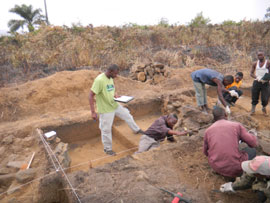
Training of PhD students, stratigraphic analysis
at Kindoki 4.
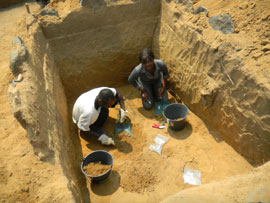
Training of PhD students, excavation of a burial
at Kindoki 4.
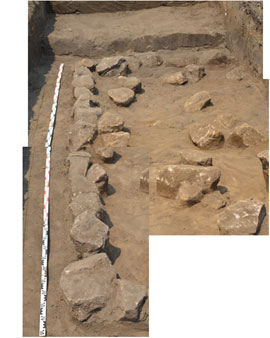
View of the house excavated on the southern
side of the Ngongo Mbata church.

Test trench 1 at Ngongo Mbata village.
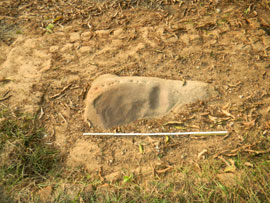
Ntadi Nia Mbele.
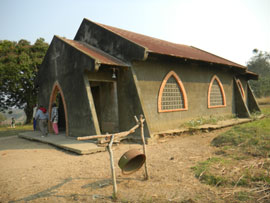
Mbata Kulunsi church.
Archaeological fieldwork in the Lower Congo province (DRC): summer 2012
Objectives:
Test excavate two of the provincial cities of the Kongo kingdom located today in Lower-Congo (DRC: Mbanza Nsundi and Mbanza Mbata),
locate the earliest village layers, carry out surveys to identify new archaeological sites around Mbanza Nsundi and Mbanza Mbata,
reevaluate the church at Ngongo-Mbata previously excavated in 1938, and train in the field two congolese PhD students who will enrol at Brussels and Ghent universities.
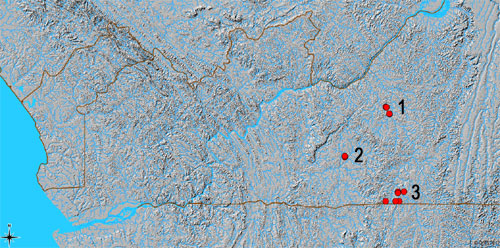
Map of fieldwork and studied archaeological sites in Lower-Congo province:
1 = Mbanza Nsundi area, 2 = Kwilu Ngongo area, 3 = Mbanza Mbata area.
Fieldwork:
Surveys and excavations were carried out from July 23 to August 31, in and around Mbanza Nsundi some 10 km north of Kisantu (location map n°1), on the road between Mbanza Nsundi and Mbanza Mbata (location map n°2), and in and around Mbanza Mbata (location map n°3).
In Mbanza Nsundi, due to preliminary discussions held during our visit in
May 2012 we tried to locate an old church on the Kindoki hilltop immediately north of Mbanza Nsundi village. While several archaeological
sites of some interest were identified in the immediate neighbourhood (two Stone Age sites between Kisantu and Mbanza Nsundi and two Iron Age sites
between Mbanza Nsundi and Lemfu towards the Congo river), our two weeks of surveys and excavations mainly focussed on Kindoki.
Two Iron Age sites were identified there during the surveys (Kindoki 1 and 2), a small burial site with European made objects (Kindoki 3) was marked for future work, and the burial site of the Mani Nsundi linked to modern day oral traditions was located. Excavations on these sites, planned for the 2013 field season, depend on the approval of traditional authorities.
The main discovery was a number of stone structures subsequently identified as a small cemetery of eleven tombs which was unknown to the villagers. It is located on the site where village elders commonly situate the old church. Excavations were concentrated there at Kindoki 4. Deep trial trenches were dug in the sandy or sandy clayey mantle to try to find the earliest village occupation on the hilltop.
At Kindoki 4 we found from bottom up, a Stone Age layer at -2,2 metres, two Iron Age village layers at -60/-80 cm and -40/-60 cm depth, the small cemetery capped by a last and recent Iron Age village layer.
Radiocarbon dates being currently processed should clarify the chronology of the Iron Age occupations. An area at the end of the southern trial trench (40 metres long) is particularly promising with a deep (-60/-80 cm) archaeological layer, small pits, pottery, smoking pipes followed on 15 square metres.
While traveling south to Mbanza Mbata, two Stone Age sites were surveyed near Kwilu Ngongo (localion map, n°2)..
After some surveys in and around the small town of Kimpangu (one Stone Age site in Kimpangu, one dual Stone Age / Iron Age (Mbafu Tradition)
site on the road to Mbanza Mbata), surveys and test excavations were carried out during one week on the old Ngongo Mbata village hilltop and at the Capuchin church excavated in 1938 south of Ngongo Mbata by M. Bequaert of the Tervuren museum.
While a single and thick Iron Age village layer was found at Ngongo Mbata village overlying a Stone Age quartz layer, excavations at Ngongo Mbata Church resulted in the discovery of one stone rectangular structure which long axis runs parallel to the south wall of the church. Test pits around showed several similar structures exist east of the excavated one.
Before leaving the Mbanza Mbata plateau, a survey and some test excavations were carried out at Mbanza Mbata itself.
The absence of current-day villages on these hilltops where the sites of Kindoki 4, Mbanza Mbata and Ngongo Mbata are situated, will facilitate the extensive excavations there next year.
Several interviews were carried out at Mbata Kulunsi (east of the Inkisi river) and at Ntadi Dia Mbele (north-east of Mbanza Mbata) regarding ancient stone blocks today associated to Christian beliefs and legends; information was gathered (interviews, photographs) about the recent history (since 1911) of the Mbata Kulunsi cross destroyed in 1994. Mbata Kulunsi is well known due to the Catholic church annual pilgrimage.
Results:
- 270 square metres excavated;
- Seven radiocarbon dates awaited;
- New samples for pottery typology;
- One column three metres thickness for palaeo-environmental analysis spanning
several thousands of years;
- One small necropolis containing 11 tombs probably dated between the 15th. and
18th. centuries;
- Four sites identified for further and extensive excavations in 2013 (Kindoki 4,
Mbanza Mbata, Ngongo Mbata village, Ngongo Mbata church);
- Fielwork training of two congolese PhD students during two weeks.
Acknowledgments:
All our thanks go to:
- the chefs de village and of groupements of Mbanza Nsundi, Kindoki, Sabala,
Malau, Ngongo Mbata, Kimfuti,
- the villagers employed as workers for the excavations in Mbanza Nsundi/Kindoki,
Mbanza Mbata, and Ngongo Mbata,
- Dr. J. Imbongo, Mr. Clément Mambu, and Ms. Jeanine Yogolelo from the Institut
des Musées Nationaux du Congo (IMNC) for their administrative help in Kinshasa,
- Mr. A. Nkanza Lutayi (IMNC) for his help during fieldwork and his help
communicating with kikongo villagers,
- Mr. I. Matonda and Ms. W.M. Kaumba, both of them assistants to the Kinshasa
and Lubumbashi universities, now PhD students at Ghent and Brussels
universities, for their help during the Kindoki 4 excavations,
- the staff of the Procure Sainte Anne in Kinshasa (Gombe) for their help and
assistance,
- and last but not least Ms. Maaike Goethals secretary at the Ghent University
Department of Languages and Cultures and attached to the KongoKing
research project.
